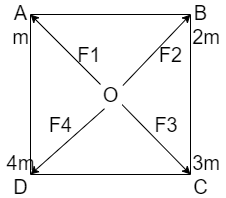
Four particles of masses m, 2m, 3m and 4m are placed at the corners of a square of side of length ‘a’. The gravitational force on a particle of mass m placed at the centre of the square is
A) \[4\sqrt 2 \dfrac{{G{m^2}}}{{{a^2}}}\]
B) $3\sqrt 2 \dfrac{{G{m^2}}}{{{a^2}}}$
C) $2\sqrt 2 \dfrac{{G{m^2}}}{{{a^2}}}$
D) $\sqrt 2 \dfrac{{G{m^2}}}{{{a^2}}}$
Answer
219.3k+ views
Hint: Recall Newton’s law of universal gravitation. According to this law, every object attracts other objects in the universe. The force of attraction points in a straight line between the centre of both the objects. It is directly proportional to the mass of the objects and inversely proportional to the square of distance between them.
Complete step by step solution:
The formula for gravitational force is given by
$F = \dfrac{{G{m_1}{m_2}}}{{{r^2}}}$
Where G is the gravitational force
${m_1}$ is the mass of the first object
${m_2}$ is the mass of the second object
And ‘r’ is the distance between them
Given that the length of each side of the square is = a
The distance of each corner from the centre will be $ = \dfrac{a}{{\sqrt 2 }}$

The gravitational force on point O due to point A is given by
\[\Rightarrow {F_1} = \dfrac{{Gmm}}{{{{(\dfrac{a}{{\sqrt 2 }})}^2}}} = \dfrac{{2G{m^2}}}{{{a^2}}}\]
Similarly, the gravitational force on point O due to point B is written as
$\Rightarrow {F_2} = \dfrac{{G(2m)(m)}}{{{{(\dfrac{a}{{\sqrt 2 }})}^2}}} = \dfrac{{4G{m^2}}}{{{a^2}}}$
The gravitational force on point O due to point C will be
$\Rightarrow {F_3} = \dfrac{{G(3m)(m)}}{{{{(\dfrac{a}{{\sqrt 2 }})}^2}}} = \dfrac{{6G{m^2}}}{{{a^2}}}$
The gravitational force on point O due to point D will be
$\Rightarrow {F_4} = \dfrac{{G(4m)(m)}}{{{{(\dfrac{a}{{\sqrt 2 }})}^2}}} = \dfrac{{8G{m^2}}}{{{a^2}}}$
The net force of ${F_1}$and ${F_3}$on point O is given by
$\Rightarrow {F_{13}} = {F_3} - {F_1}$
$\Rightarrow {F_{13}} = \dfrac{{6G{m^2}}}{{{a^2}}} - \dfrac{{2G{m^2}}}{{{a^2}}} = \dfrac{{4G{m^2}}}{{{a^2}}}$
Similarly, the force of ${F_2}$and${F_4}$on point O is given by
$\Rightarrow {F_{24}} = {F_4} - {F_2}$
$\Rightarrow {F_{24}} = \dfrac{{8G{m^2}}}{{{a^2}}} - \dfrac{{4G{m^2}}}{{{a^2}}} = \dfrac{{4G{m^2}}}{{{a^2}}}$
The magnitude of net force on point O is given by
$\Rightarrow F = \sqrt {{{({F_{13}})}^2} + {{({F_{24}})}^2}} $
$\Rightarrow F = \sqrt {{{(\dfrac{{4G{m^2}}}{{{a^2}}})}^2} + {{(\dfrac{{4G{m^2}}}{{{a^2}}})}^2}} $
$\Rightarrow F = \sqrt {2.\dfrac{{4{G^2}{m^4}}}{{{a^4}}}} $
\[\Rightarrow F = 2\sqrt 2 \dfrac{{G{m^2}}}{{{a^2}}}\]
Option C is the right answer.
Note: It is important to note that since the force of gravitation is directly proportional to the mass of the object, so an object with more mass will have a large force of gravitation. But it varies inversely with the square of distance, so if the distance is doubled the force of gravitation will decrease by 4 times and so on.
Complete step by step solution:
The formula for gravitational force is given by
$F = \dfrac{{G{m_1}{m_2}}}{{{r^2}}}$
Where G is the gravitational force
${m_1}$ is the mass of the first object
${m_2}$ is the mass of the second object
And ‘r’ is the distance between them
Given that the length of each side of the square is = a
The distance of each corner from the centre will be $ = \dfrac{a}{{\sqrt 2 }}$

The gravitational force on point O due to point A is given by
\[\Rightarrow {F_1} = \dfrac{{Gmm}}{{{{(\dfrac{a}{{\sqrt 2 }})}^2}}} = \dfrac{{2G{m^2}}}{{{a^2}}}\]
Similarly, the gravitational force on point O due to point B is written as
$\Rightarrow {F_2} = \dfrac{{G(2m)(m)}}{{{{(\dfrac{a}{{\sqrt 2 }})}^2}}} = \dfrac{{4G{m^2}}}{{{a^2}}}$
The gravitational force on point O due to point C will be
$\Rightarrow {F_3} = \dfrac{{G(3m)(m)}}{{{{(\dfrac{a}{{\sqrt 2 }})}^2}}} = \dfrac{{6G{m^2}}}{{{a^2}}}$
The gravitational force on point O due to point D will be
$\Rightarrow {F_4} = \dfrac{{G(4m)(m)}}{{{{(\dfrac{a}{{\sqrt 2 }})}^2}}} = \dfrac{{8G{m^2}}}{{{a^2}}}$
The net force of ${F_1}$and ${F_3}$on point O is given by
$\Rightarrow {F_{13}} = {F_3} - {F_1}$
$\Rightarrow {F_{13}} = \dfrac{{6G{m^2}}}{{{a^2}}} - \dfrac{{2G{m^2}}}{{{a^2}}} = \dfrac{{4G{m^2}}}{{{a^2}}}$
Similarly, the force of ${F_2}$and${F_4}$on point O is given by
$\Rightarrow {F_{24}} = {F_4} - {F_2}$
$\Rightarrow {F_{24}} = \dfrac{{8G{m^2}}}{{{a^2}}} - \dfrac{{4G{m^2}}}{{{a^2}}} = \dfrac{{4G{m^2}}}{{{a^2}}}$
The magnitude of net force on point O is given by
$\Rightarrow F = \sqrt {{{({F_{13}})}^2} + {{({F_{24}})}^2}} $
$\Rightarrow F = \sqrt {{{(\dfrac{{4G{m^2}}}{{{a^2}}})}^2} + {{(\dfrac{{4G{m^2}}}{{{a^2}}})}^2}} $
$\Rightarrow F = \sqrt {2.\dfrac{{4{G^2}{m^4}}}{{{a^4}}}} $
\[\Rightarrow F = 2\sqrt 2 \dfrac{{G{m^2}}}{{{a^2}}}\]
Option C is the right answer.
Note: It is important to note that since the force of gravitation is directly proportional to the mass of the object, so an object with more mass will have a large force of gravitation. But it varies inversely with the square of distance, so if the distance is doubled the force of gravitation will decrease by 4 times and so on.
Recently Updated Pages
Two discs which are rotating about their respective class 11 physics JEE_Main

A ladder rests against a frictionless vertical wall class 11 physics JEE_Main

Two simple pendulums of lengths 1 m and 16 m respectively class 11 physics JEE_Main

The slopes of isothermal and adiabatic curves are related class 11 physics JEE_Main

A trolly falling freely on an inclined plane as shown class 11 physics JEE_Main

The masses M1 and M2M2 M1 are released from rest Using class 11 physics JEE_Main

Trending doubts
JEE Main 2026: Application Form Open, Exam Dates, Syllabus, Eligibility & Question Papers

Understanding Uniform Acceleration in Physics

Derivation of Equation of Trajectory Explained for Students

Hybridisation in Chemistry – Concept, Types & Applications

Understanding the Angle of Deviation in a Prism

Understanding Collisions: Types and Examples for Students

Other Pages
JEE Advanced Marks vs Ranks 2025: Understanding Category-wise Qualifying Marks and Previous Year Cut-offs

Units And Measurements Class 11 Physics Chapter 1 CBSE Notes - 2025-26

NCERT Solutions For Class 11 Physics Chapter 8 Mechanical Properties Of Solids

Motion in a Straight Line Class 11 Physics Chapter 2 CBSE Notes - 2025-26

NCERT Solutions for Class 11 Physics Chapter 7 Gravitation 2025-26

Understanding Atomic Structure for Beginners




